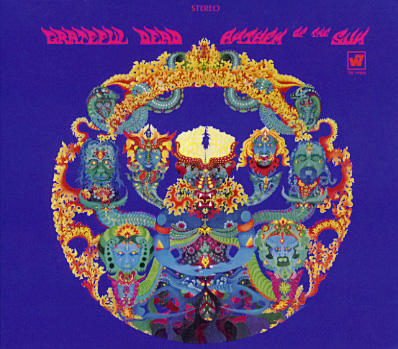The Grateful Dead: Anthem of the Sun (1968)
Anthem of the Sun was of course, the Dead’s second album, and the first to bring in Mickey Hart and Tom Constanten (although Constanten’s appearance on this album was unofficial, although that would quickly change). Tom Constanten was brought in for the most complex keyboard duties, since Ron “Pigpen” McKernan tended to prefer more simple R&B-influenced playing.
This has simply got to be the most “far out” album to come out of the late ’60s Bay Area. For this album, the band recorded a bunch of stuff in the studio, and included a bunch of live snippets which they spliced in. Phil Lesh was apparently a big fan of avant garde classical like John Cage and Karlheinz Stockhausen, and it shows here. The album starts off with “That’s It For the Other One”. Here you get treated with Jerry Garcia’s unmistakable voice. I really love how the music kicks into high gear. The intensity is unbelievable, and you gotta hear it to believe it (especially if you thought the Dead were always mellow and laid-back). During these more intense moments, Bob Weir takes his turn at singing. The original theme returns, another intense guitar solo, then comes some really bizarre experiments that end this odd piece. The band then does mellow out with “New Potato Caboose”, which is dominated by vocals, harpsichord, celeste, and acoustic guitar. Despite the acoustic nature of this piece, it’s still quite different from the folk/country-influenced albums of 1970, Workingman’s Dead and American Beauty. “Born Cross-Eyed” is a rather short piece, with some Spanish influence, especially from the trumpet (courtesy of Phil Lesh, who was trained on that instrument before turning to bass). Mickey Hart’s presence can be felt on this next piece, “Alligator”. The vocal section features piano and kazoo, but then this piece goes into percussion overdrive, with both Bill Kreutzmann and Mickey Hart. It’s no mistaking what parts Mickey Hart is playing: all those percussion instruments (he is a big percussion nut, and it shows, not to mention you should get his 1990 book co-written by Jay Stevens called Drumming at the Edge of Magic, although a tie-in for a solo album Hart was doing at the time, called At the Edge, shows his enthusiasm for percussion clearly). Next is the final cut: “Caution (Do Not Stop on Tracks)”. It starts off with some semi-spoken dialog from Pigpen, and lots of percussion, then the music goes off into some really tripped-out experiments that close this album.
Warning: around 1971, this album, as well as their followup, Aoxomoxoa received some new, extended remixing, and apparently the current CD reissues with all those live bonus cuts consists of the 1971 remix for the original album part, so exercise caution when buying these albums (if you collect LPs, it’s safe you have the originals if it has the green “W7” label). Sadly I never heard the original mix of these two albums, so I’m unable to say the difference.
Now this album isn’t going to appeal to everyone. Some will write it off as “noise” that you have to be stoned to appreciate. But for those who want something off-the-wall, or curious of how the Dead sounds at their most experimental, then go for this album.
– Jerry Garcia: guitar, vocals
– Bob Weir: guitar, vocals
– Phil Lesh: bass guitar, trumpet
– Ron Pigpen McKernan: organ
– Bill Kreutzmann: drums
– Mickey Hart: drums, percussion
– Tom Constanten: keyboards
 Buy This CD!
Buy This CD!